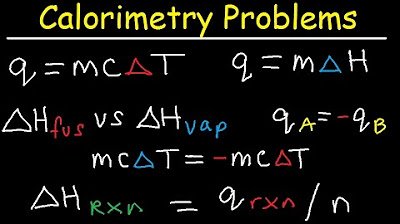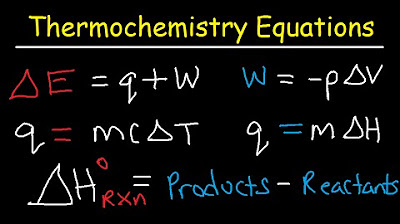Calorimetry Examples: How to Find Heat and Specific Heat Capacity
TLDRThis video script offers an in-depth look at calorimetry, presenting the fundamental formula q = mCΔT for calculating heat transfer in terms of mass, specific heat capacity, and temperature change. It guides viewers through two examples: calculating heat release in lead and determining aluminum's specific heat capacity. The script also promotes a comprehensive 50-page Thermochemistry guide, which includes test questions and step-by-step solutions, available through a link in the description box, along with other educational resources.
Takeaways
- 🔍 The fundamental formula in calorimetry is q = mCΔT, where q is heat, m is mass, C is specific heat capacity, and ΔT is the change in temperature.
- 📏 Units must be consistent with the formula: q in kJ or J, m in grams, C in J/g°C, and ΔT in °C.
- 📚 The script is part of a 50-page guide on Thermochemistry, which includes comprehensive information and step-by-step answers to common test questions.
- 🔢 Example 1 involves calculating the heat released by cooling 497 g of lead from 37.2°C to 22.5°C, using the specific heat capacity of lead (0.129 J/g°C).
- ❄️ The heat released is negative, indicating a decrease in temperature, and the calculation results in -942 J or 942 J released.
- 📈 Example 2 calculates the specific heat capacity of aluminum, given a 120 g sample absorbs 9612 J and the temperature rises from 25.0°C to 115°C.
- 🌡 Change in temperature (ΔT) is calculated by subtracting the initial temperature from the final temperature.
- 📉 The formula for heat (q) rearranges to solve for specific heat capacity (C) by dividing the heat absorbed by the product of mass and ΔT.
- 📝 The calculated specific heat capacity of aluminum is 0.89 J/g°C, obtained by dividing the absorbed heat by the change in temperature and mass.
- 📘 The script emphasizes the importance of using the correct units and the significance of understanding the direction of heat flow (absorbed or released).
- 📚 Additional resources, including a thermochemistry guide, homework help, and online tutoring, are available in the description box for further assistance.
Q & A
What is the main formula used in calorimetry?
-The main formula used in calorimetry is q = m * C * ΔT, where q is the heat measured in kJ or J, m is the mass in grams, C is the specific heat capacity in J/g°C, and ΔT is the change in temperature in Celsius.
What units should be used for the variables in the calorimetry formula?
-The units for the variables in the calorimetry formula should be: q in kJ or J, m in grams, C in J/g°C, and ΔT in Celsius.
What does the change in temperature (ΔT) represent in the calorimetry formula?
-ΔT represents the difference between the final temperature and the initial temperature, measured in Celsius.
What is the significance of the negative sign in the heat released during the cooling of a substance?
-The negative sign indicates that heat is being released by the substance during the cooling process, meaning energy is leaving the system.
How can you find the heat released when a substance cools down?
-To find the heat released, you calculate the change in temperature (final temperature minus initial temperature), and then multiply it by the mass of the substance and its specific heat capacity.
What is the specific heat capacity of lead according to the example provided?
-The specific heat capacity of lead is given as 0.129 J/g°C.
How much heat is released when 497 g of lead is cooled from 37.2°C to 22.5°C?
-The heat released can be calculated using the formula q = m * C * ΔT. For 497 g of lead, the heat released is approximately -942 J (or 942 J released, without the negative sign).
What does it mean when a substance 'absorbs' heat energy?
-When a substance absorbs heat energy, it means that energy is being taken into the system, causing an increase in temperature.
How can you find the specific heat capacity of a substance if you know the mass, the heat absorbed, and the change in temperature?
-You rearrange the calorimetry formula to solve for C: C = q / (m * ΔT), and then plug in the known values to find the specific heat capacity.
What is the specific heat capacity of aluminum found in the second example?
-The specific heat capacity of aluminum in the second example is found to be 0.89 J/g°C.
Where can one find additional resources on Thermochemistry and calorimetry?
-Additional resources, including a 50-page guide on Thermochemistry, can be found in the description box of the video, along with links to other helpful resources like homework help and online tutoring.
Outlines
🔍 Calorimetry Formula and Thermochemistry Guide Overview
This paragraph introduces the fundamental formula for calorimetry, q = mCΔT, where q represents heat in kJ or J, m is the mass in grams, C or Cs is the specific heat capacity in J/g°C, and ΔT is the temperature change in Celsius. The importance of using the correct units is emphasized, and viewers are directed to a comprehensive 50-page Thermochemistry guide available in the description for further information and practice. Two examples are outlined: one calculating the heat released by cooling lead and the other determining the specific heat capacity of aluminum, highlighting the process and significance of each step.
Mindmap
Keywords
💡Calorimetry
💡q
💡m
💡Specific Heat Capacity (C or Cs)
💡ΔT
💡Thermochemistry
💡Joule (J)
💡Kilojoule (kJ)
💡Significant Figures
💡Formula
💡Example Problems
Highlights
The main formula in calorimetry is q = mCΔT, where q is heat, m is mass, C is specific heat capacity, and ΔT is the change in temperature.
Heat q is measured in kJ or J, mass m in grams, and specific heat capacity C in J/g°C.
ΔT is the final temperature minus the initial temperature, measured in Celsius.
Ensure all values are in the correct units before using the formula.
A 50-page guide on Thermochemistry is available, including test questions and step-by-step answers.
Example 1 involves finding the heat released by cooling lead.
The specific heat of lead is given as 0.129 J/g°C.
Heat released is calculated using the formula with given mass and temperature change.
The change in temperature is calculated by subtracting the initial temperature from the final temperature.
The result should be rounded to three significant figures.
Heat can be expressed with or without the negative sign, indicating release.
Example 2 involves finding the specific heat capacity of aluminum.
The mass and heat absorbed by aluminum are given, along with the initial and final temperatures.
The specific heat capacity is calculated by dividing the heat by the mass and temperature change.
The specific heat capacity of aluminum is found to be 0.89 J/g°C.
A thermochemistry guide is recommended for further assistance with calorimetry and thermochemistry.
Additional resources such as homework help and online tutoring are available in the description box.
Transcripts
Browse More Related Video

Calorimetry Problems, Thermochemistry Practice, Specific Heat Capacity, Enthalpy Fusion, Chemistry

Thermochemistry Equations & Formulas - Lecture Review & Practice Problems

Latent Heat of Fusion and Vaporization, Specific Heat Capacity & Calorimetry - Physics

Thermochemistry Equations and Formulas With Practice Problems

Entropy Change For Melting Ice, Heating Water, Mixtures & Carnot Cycle of Heat Engines - Physics

6.2 Calorimetry | High School Chemistry
5.0 / 5 (0 votes)
Thanks for rating: